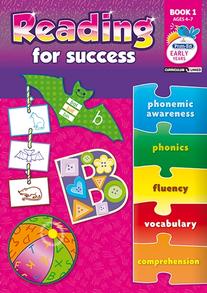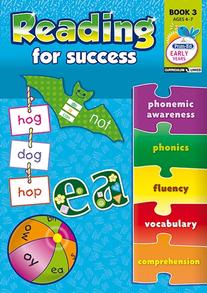-
0
Your cart is currently empty.
-
0
Your cart is currently empty.
Reading for Success: Book 1
Preview Book
- Format: Photocopiable Books
- Series: Reading for Success
- Code: 6216 | ISBN: 9781846547485
- Subject: English
- Levels: Junior Infants, Senior Infants
Price:
29.95
Quantity:
Reading for Success - Book 1 provides teacher directed lessons and independent pupil activities that focus on five key elements of reading:
- phonemic awareness
- phonics
- fluency
- vocabulary
- comprehension
This book provides Infant Class teachers with practical strategies for teaching reading skills. Varied activities allow opportunities for direct instruction, paired pupil learning and small group instruction, learning centres and independent practice. Assessments help track pupils progress and conceptual development.
-
As fluency was a focus during Term 3 I wanted to explore more resources available across all classes. Prim-Ed sent me this series of books to use in class. Reading for Success is a series of 4 books that can be used from the early stages of Junior Infants up to 1st or 2nd class depending on your class. Each book focuses on the skills of Phonemic Awareness, Phonics, Fluency, Vocab and Comprehension. Each book also contains a variety of assessments that would be valuable for all infant teachers along with teachers in a Special Ed. setting. Within each section of the book there is a information page, it describes the skill in more detail, its importance in Literacy and it outlines different elements of the skill in more detail. It then lists a variety of general strategies and activities that could be used in the class on a daily basis. The next part of each section contains a variety of printables to be used in the class. You could spend so much time creating a bank of resources for each section/skill to be used in station teaching, but all these activities are contained in one book. There are also assessments within most of the sections which can be used to highlight areas that may need further support along with general overview of the class. I really like these books, I am particularly impressed with the detail within the phonemic awareness section. Phonemic awareness can often be overlooked and these books really highlight different activities and strategies that can be used across the junior classes in the school. The comprehension section in Book 4 include a section on graphic organisers which could also be used in 3rd class or 4th class. The graphic organisers include flow charts to analyse the plot and the characters which are areas that could be developed further in 3rd and 4th class. Books 3 & 4 also contain activities on idioms which I think the children will love. Often we can focus on comprehension skills and answering questions but in order to develop vocabulary and fluency the children must explore words and play with them. Through playful activities the children can explore words with multiple meanings and the use of idioms and puns which may also help their creative writing. Overall, I am really impressed with these books! I feel they would be a valuable resource in the junior classes within the school with the possibility of sharing resources to 3rd class too. I think each section is manageable with daily activities in the class and structured activities for lessons or station teaching.
Aistear Múinteoir -
What I like about these books is the clarity and ease they provided for me to supplement the reading books and approaches I aready use in a meaningful and careful, planned way. Other aspects I welcomed were the assessment tools for each element of reading that was being taught. Absolutely an essential for the teacher and child’s assessment portfolio. The assessment tests have not been simply pulled out of the air, they are taken or adapted from carefully constructed researched tests available to educators. For example, the Phonemic Awareness Assessment test in Book 1 was adapted with permission from the Pre-phonics Tests:Phonemic Awareness and more by Doctor Fry. In the Fluency section, there are many photocopiable resources such as reading diary records, reading award templates, nursery rhymes with activties and readers’ theatre scripts, Within the Comprehension section, we have some graphic organisers like story maps, sequencing maps, text webs, stop and predict and story frames. Book 1 starts with the basics and each book develops the reading element further, making it a very careful and motivating program for any class to follow. I am very impressed with this product and think that every school should have one. I am going to give it the “Star of the Class” award.
Anseo.net -
This is another infant resource which I recently received. It covers literally every aspect of teaching children how to read, from phonemic awareness, to phonics, from fluency to vocabulary and comprehension, it’s all here. It is an extremely detailed resource, for example phonemic awareness one covers phonemic isolation, identity, categorisation, blending, segmentation, deletion, addition and substitution. I t also offers a wonderful phonemic awareness assessment which will help you to identify immediately if you have a child who is struggling with this area. The resource offers segmented word cards for CVC words. Reading for Success offers the teacher a number of fun activities for phonic games, with templates provided. It also provides templates for games based on initial sounds and ending sounds. It progresses then to medial sounds, including short to long vowels with many activity sheets on long and short vowels. These in particular would be a brilliant form of revision come the end of the year. I know most junior and senior infant teachers use Jolly Phonics or Letterland. There aren’t a huge amount of resources available in my opinion for teaching reading, but this resource booklet has everything you need for hands on reading activities. As reading is so technical, I know many NQT’s may be unsure of where to even begin with it, from phonemes to phonics etc, but this resource explains everything in a nutshell! Then the lovely word families-there is a really fun activity called ‘Spin the Word’ for these! The book moves on then to reading aloud. It gives many examples of songs and poems to start children off with as they first encounter reading aloud. It explains the whole process to the teacher, from pupil adult reading, to echo reading, choral reading, partner reading, songs and group divisions. Best of all, this book contains templates for the children to create their own book! This would be a big hit in the classroom. It also has a section on readers theatre, which would be so much fun! It has some lovely themes, such as community helpers. The finals section of the book deals with teaching vocabulary and comprehension, it suggests a variety of ways, as you can choose which way suits your class best. It contains a number of simple comprehension pieces at the back of the book which would be a perfect way os assessing your class’s comprehension skills throughout the year. It took me so long to get through this resource book as it is so technical in nature! But that is the nature of teaching children how to read, and this book will see you through the year with many fun activities, templates and suggestions for your class!
Múinteoir Valerie




